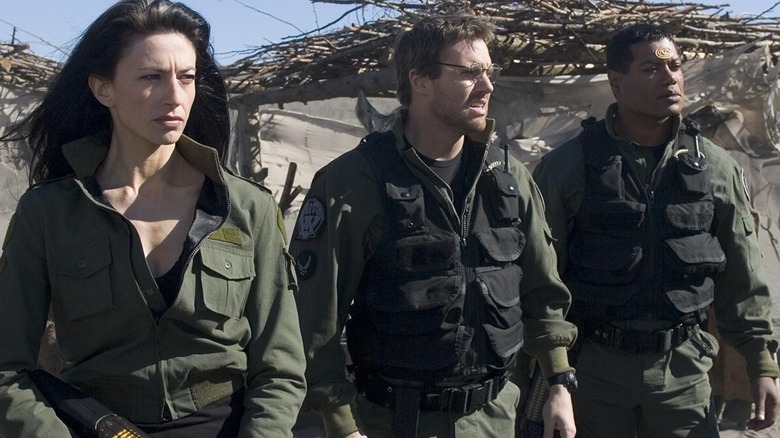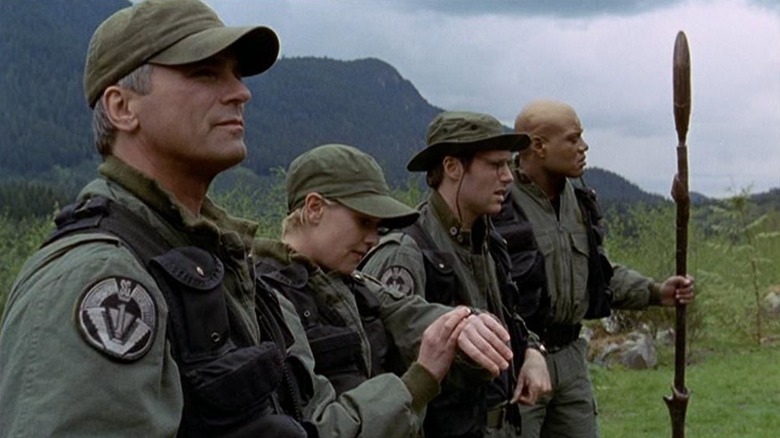Stargate's Sci-Fi Settings Noticeably Declined Due To Real World Expansions
This post contains spoilers for the "Stargate" franchise.
Roland Emmerich's 1994 sci-fi drama "Stargate" posits an intriguing premise. An ancient ring-shaped device excavated during an archaeological expedition in Giza turns out to be a two-way portal connecting similar devices on distant plants, using a wormhole as a means to transport people. The film's elaborate plot gradually reveals that extraterrestrial beings enslaved parts of the human civilization, and used the Stargate device to trap them in their home planets across the galaxy. Brad Wright and Jonathan Glassner's beloved series "Stargate SG-1" builds its foundation on the film's lore, expanding a dystopian world where military organizations on Earth use the Stargate to free the enslaved humans and protect the planet from a vicious alien race known as the Goa'uld.
"SG-1" ran for 10 seasons over a span of 10 years, and birthed a sprawling franchise dedicated to enriching its mythos, so much so that it can be tricky to keep up with a coherent watch order. Wright and Glassner's series was popular for good reason, as it drew from existing myths to etch surreal, fantastical worlds, explored by grounded characters dedicated to unraveling the truth about humankind. Antagonistic alien races like the Replicators and the Ori revealed new facets about sentient life in the universe, where not every civilization is benevolent or receptive to peaceful negotiations, but eager to subjugate on sight.
While "SG-1" consistently subverted expectations with its evolving storyline, it soon became challenging to cook up new settings, especially ones that were supposed to look like alien planets. An overreliance on visual effects was not plausible for technical and budgetary reasons, and Wright himself revealed a real-world factor that affected the quality of the show's sci-fi settings in a Reddit AMA conducted a year ago.
Stargate struggled with revamping its Colorado setting
A Reddit user asked Wright about the "most frustrating roadblocks" he faced while writing the episodes, especially in terms of making the planets seem fantastical enough while shooting in the forests of British Columbia. Wright acknowledged that this was fairly challenging, and access to technological aids like The Volume (immersive, 3D backdrops that efficiently replace green screens) would have made "all the difference:"
"Yes, it grew increasingly difficult and frustrating to go out into the woods of British Columbia and pretend it was another planet. Especially since Vancouver kept growing into the open spaces we were using. Video walls like those used by the 'Star Wars' series would make all the difference today."
Scenes that took place at the Stargate Command Center were easier to shoot, as filming took place at Cheyenne Mountain Air Force Station near Colorado Springs. Adjacent locations have been smartly used throughout the series, such as the Vancouver Art Gallery, featured in season 2, and Jericho Beach, which was transformed into the homeworld of the Nem, an alien race. However, the locations start to feel a little stale after a point, as they all look like remote parts of the same area remodeled to appear like an extraterrestrial world.
Some earlier episodes circumvented this issue with creative storytelling, such as "Cold Lazarus," which took place on a sulfurous planet, allowing the design team to cover the landscape with sulfur and camouflage the sameness of the area (via GateWorld).
Perhaps a new "Stargate" series taking full advantage of state-of-the-art tech can bring such dreary, beautiful worlds to life in vivid detail, paving the path to a new journey among the stars.

